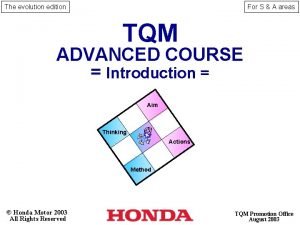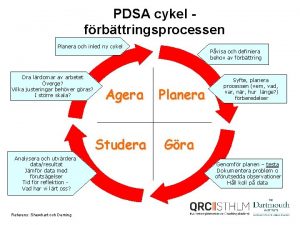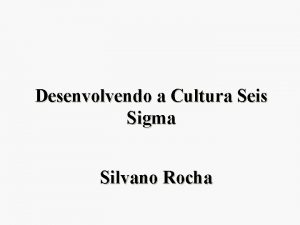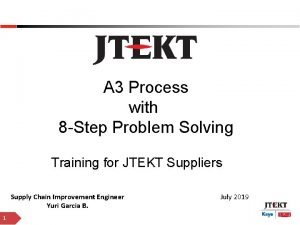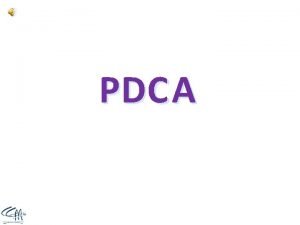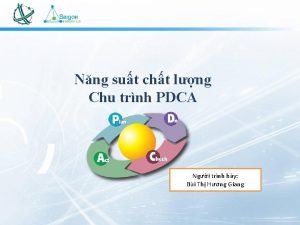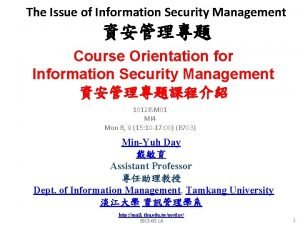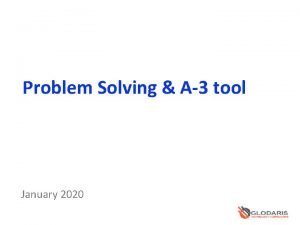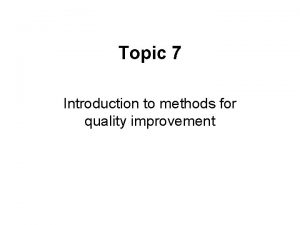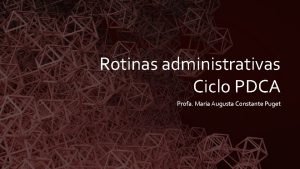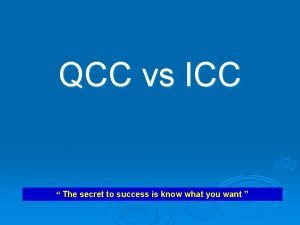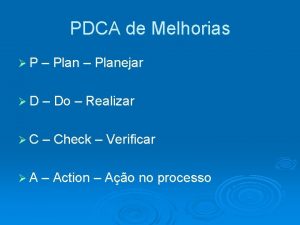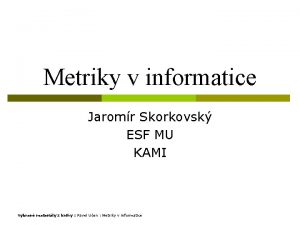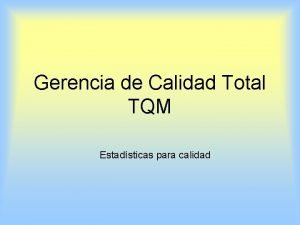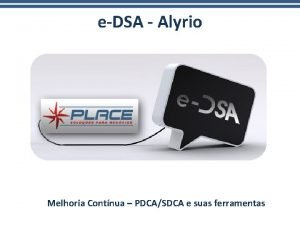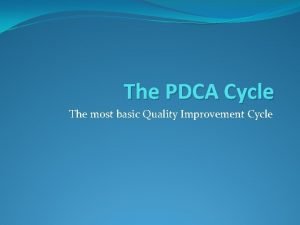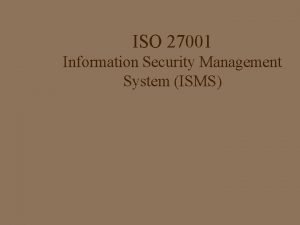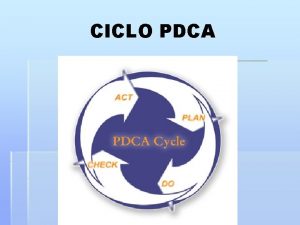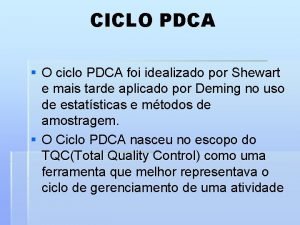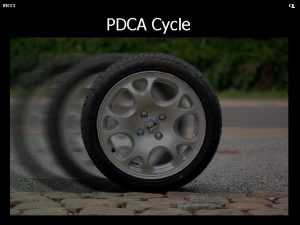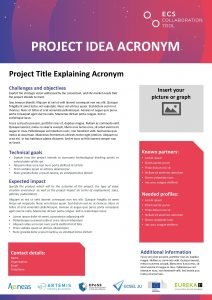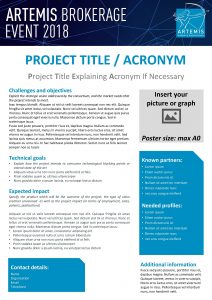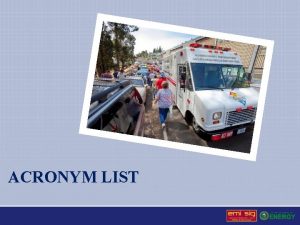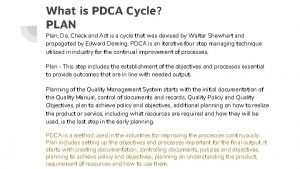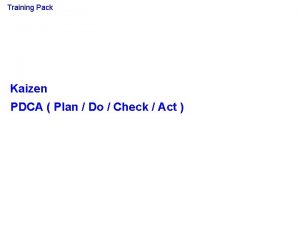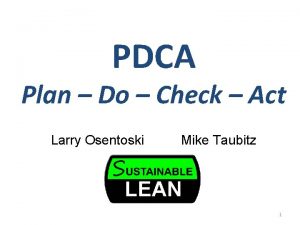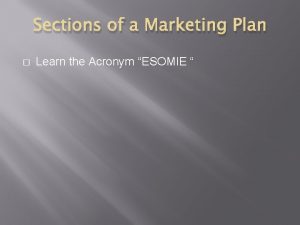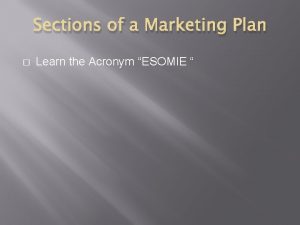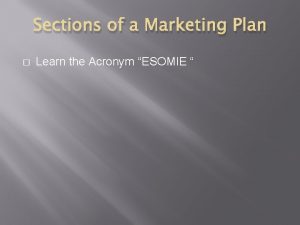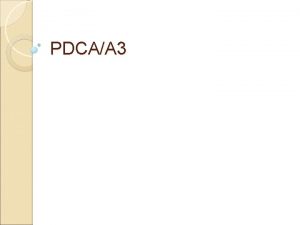PDCA PDCA is the acronym for Plan Do
























- Slides: 24

PDCA • PDCA is the acronym for Plan, Do Check, Act Image source http: //www. netcoach. eu. com/index. php? id=36 Plan

When to Use Plan–Do–Check–Act As a model for continuous improvement. When starting a new improvement project. When developing a new or improved design of a process, product or service. When defining a repetitive work process. When planning data collection and analysis in order to verify and prioritize problems or root causes. • When implementing any change. • • • Source http: //asq. org/learn-about-quality/project-planningtools/overview/pdca-cycle. html

The Elements • Plan – so, we’ve set a strategic goal (remember the exercise we did? ) Now, what questions do we have to consider to get there? • How will the goals be met? • What data collection do you need to consider? This is necessary to plan as we’ll need it in the check stage • Do – actual execution. Small scale is best to start • One department • One process • Single item

Check • This is where benchmarking comes into play, and why the metrics we spoke about earlier are important • Did we make a statistically significant and practical difference? • There a variety of comparison tools you can use to test if you are on the right track. We’ll talk about this in the section on “ 7 Quality Tools”

Act • ASQ finds the act phase as comparable to “standardize. ” This is very true when the outcome is positive at the desired level. • Act can also be the stage at which you go back to plan because you didn’t achieve the intended goal. • Even if a positive outcome is achieved, remember that this is a cycle. Consider the following example:

Example PDCA Lens grind station #1 Your team saw that scratched lens was the leading defect for the department. You planned to put in an air curtain to keep dust out. You installed the curtain (Do) on one station to evaluate results, and then measured the results (checked). You Act by putting this on all of the stations…

Cont’d • At some future point, your team is going to tackle the other two problems which are now queued ahead of it. • when scratched lens comes back around to being the major problem, it will enter the PDCA cycle for a 2 nd iteration

Sort • Sort is the first of the 5 S’s • Concentration is on Sorting out the equipment or items which are: • No longer in use • Need repair • Are broken beyond repair • Items should be moved to a “red tag” area for review http: //www. kaizenworld. com/_Media/5 sexplanation_med_hr. jpeg

Set In Order • The catchphrase for this S is, “A place for everything, everything in its place. ” • Every single item is evaluated for: • How often used • Weight • size • Based on these factors, placed in best spot for usage and ergonomics • Becomes a dedicated spot, either labeled or shadow board • In manufacturing, includes raw materials, pallets and other consumables

Sweep and Shine • Very straightforward title – but there are underlying reasons for the “deep clean” • If a machine is dirty, you often can’t see it leak oil • A machine leaking oil is a problem • Clean it so you can see the leak, then fix the leak! • Dirty filters cause loss of effectiveness, or not work at all • Bad for people if air filter, bad for machine if keeping dust out of motor • Clean the filter or replace!

Standardize • In this step, now we want to make schedules for the activity we’ve done: • How often do we clean/replace filters? • Who takes on this function? • When will it be done? Typically at end of work day – 15 minutes of concentrated cleaning activity) • Scheduling board is a good way to do this – everyone can see • Cleaning stations with everything laid out (using the 2 nd S)

Sustain • In order to keep the gains made in the other phases, we now use an audit system to ensure that all of the standardized tasks are being done. • This is very important in the ideology of continuous improvement – you can’t continuously improve unless you sustain what you have.

Root Cause Analysis • Please evaluate the following statement: • All cards with a grey back have an X on the face. O X 1 2 3 X 4 5

What is the minimum necessary cards to flip, and which ones? • Answer next slide O X 1 2 3 X 4 5

Answer… • Cards 1 and 2. • We have to flip card one, to see if there is an X on it. • We also have to flip card two, because if it has a grey back, the statement is not true. • We do not have to flip 3 and 5, because the statement did not say, only grey back cards have an X on the face (tan cards could have an X on the face too)

Supporting a Hypothesis • Sometimes we’re so eager to support a hypothesis, we only look for confirming facts • If someone stated that “All birds fly” it wouldn’t matter if they brought 2, 000 species of birds that fly Right? http: //www. clipartpanda. com/categories/penguin-clip-art-black-and-white

Causes and Symptoms • Recognizing the difference between cause and symptom is vital. • For example, a circuit breaker of fuse may occasionally trip. • However, if you are constantly having to reset or replace, then you are addressing a symptom • If you are having to remove rust from parts, is it treating a symptom or a cause? • It’s OK to treat a symptom for a short term corrective action • Long term corrective action must have the root cause addressed.

Team Fundamentals


Team Stages http: //3. bp. blogspot. com/-G 5 v. RJc. A 56 og/UKDW 6 no. Udj. I/AAAAAD 4/x. Op. Fz. E 7_5 WE/s 1600/groupstages. jpg 20

Conflict, Cont’d Positive conflict Negative conflict • Leads to mutual respect • Sharing of ideas • Blended solutions • True best idea implemented as people see beyond personal impact or ego • People retreat to their corners • Become further entrenched in paradigms • Growing hostility • Functional silos • No change made

Conflict Management Strategies Style • Accommodating • Avoiding • Collaborating • Compromising • Competing Party #1 Party #2 I lose you win no winners or losers win Use When issue is small to you, and granting other is conciliatory timing is not right, need more info, saving face foundation of trust and teamwork Big pic win, pers loss when consensus is needed to move forward I win in crisis, when you are absolutely right and can't budge You lose 22

Consensus • The Principles of Consensus Decision Making • Consensus decision making is a process used by groups seeking to generate widespread levels of participation and agreement. 1 The key take-away for consensus is that people are willing to give up personal or departmental goals for greater organizational goals. They are willing to agree on and support a course of action even if they would prefer a different course of action. http: //consensusdecisionmaking. org/Articles/Basics%20 of%20 Consensus%20 Decision%20 Making. html

• Inclusive: As many stakeholders as possible are involved in group discussions. • Participatory: All participants are allowed a chance to contribute to the discussion. • Collaborative: The group constructs proposals with input from all interested group members. Any individual authorship of a proposal is subsumed as the group modifies it to include the concerns of all group members. • Agreement Seeking: The goal is to generate as much agreement as possible. Regardless of how much agreement is required to finalize a decision, a group using a consensus process makes a concerted attempt to reach full agreement. • Cooperative: Participants are encouraged to keep the good of the whole group in mind. Each individual’s preferences should be voiced so that the group can incorporate all concerns into an emerging proposal. Individual preferences should not, however, obstructively impede the progress of the group. http: //consensusdecisionmaking. org/Articles/Basics%20 of%20 Consensus%20 Decision%20 Making. html
 Three reality principle honda
Three reality principle honda Siklus pdsa
Siklus pdsa Pdsa cykel
Pdsa cykel Bedrijfseconomie duaal
Bedrijfseconomie duaal Sigma
Sigma 8 step problem solving process
8 step problem solving process Pdca worksheet
Pdca worksheet Premier bet mali
Premier bet mali Iso 27001 pdca
Iso 27001 pdca 8 step pdca
8 step pdca Pdca itil
Pdca itil Focus pdca
Focus pdca O ciclo pdca
O ciclo pdca Pdca model
Pdca model Pdca model
Pdca model Ciclo pdca fluxograma
Ciclo pdca fluxograma Pdca příklad
Pdca příklad Diagrama de juran
Diagrama de juran Pdca significado
Pdca significado Pdca doc
Pdca doc Iso 27001 pdca model
Iso 27001 pdca model Fspos vägledning för kontinuitetshantering
Fspos vägledning för kontinuitetshantering Typiska drag för en novell
Typiska drag för en novell Tack för att ni lyssnade bild
Tack för att ni lyssnade bild Ekologiskt fotavtryck
Ekologiskt fotavtryck
